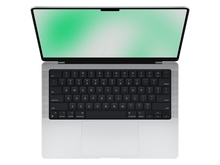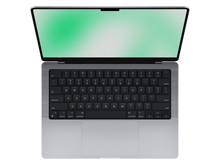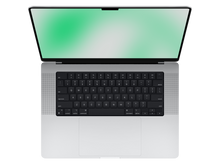-

Apple MacBook Pro 16" Space Gray, M1 Pro, 10-Core CPU and 16-Core GPU, 512 GB SSD, 16 GB RAM, Late 2021, CH
Regular price From 1'206 CHFSale price From 1'206 CHF Regular priceUnit price per0 CHF -
 Sold out
Sold outApple MacBook Air 15" Midnight, M3, 8-Core CPU and 10-Core GPU, 256 GB SSD, 16 GB RAM, Early 2024, CH
Regular price From 658 CHFSale price From 658 CHF Regular priceUnit price per0 CHF -
 Sold out
Sold outApple Macbook Pro 14" Silver, M1 Pro, 10-Core CPU & 16-Core GPU, 1 TB SSD, 16 GB RAM, Late 2021, CH
Regular price From 953 CHFSale price From 953 CHF Regular priceUnit price per0 CHF -
 Sold out
Sold outApple Macbook Pro 14" Silver, M2 Pro, 10-Core CPU & 16-Core GPU, 512 GB SSD, 16 GB RAM, Early 2023, CH
Regular price From 880 CHFSale price From 880 CHF Regular priceUnit price per0 CHF -
 Sold out
Sold outApple Macbook Pro 14" Silver, M2 Pro, 12-Core CPU & 19-Core GPU, 1 TB SSD, 16 GB RAM, Early 2023, CH
Regular price From 1'115 CHFSale price From 1'115 CHF Regular priceUnit price per0 CHF -
 Sold out
Sold outApple MacBook Pro 14" Silver, M3 Max, 14-Core CPU and 30-Core GPU, 1 TB SSD, 36 GB RAM, Late 2023, CH
Regular price From 1'642 CHFSale price From 1'642 CHF Regular priceUnit price per0 CHF -
 Sold out
Sold outApple MacBook Pro 14" Silver, M4, 10-Core CPU and 10-Core GPU, 512 GB, 16 GB RAM, Late 2024, CH
Regular price From 910 CHFSale price From 910 CHF Regular priceUnit price per0 CHF -
 Sold out
Sold outApple Macbook Pro 14" Space Grey, M1 Pro, 10-Core CPU & 16-Core GPU, 1 TB SSD, 16 GB RAM, Late 2021, CH
Regular price From 953 CHFSale price From 953 CHF Regular priceUnit price per0 CHF -
 Sold out
Sold outApple Macbook Pro 14" Space Grey, M1 Pro, 10-Core CPU & 16-Core GPU, 1 TB SSD, 32 GB RAM, Late 2021, CH
Regular price From 1'183 CHFSale price From 1'183 CHF Regular priceUnit price per0 CHF -
 Sold out
Sold outApple Macbook Pro 14" Space Grey, M1 Pro, 10-Core CPU & 16-Core GPU, 2 TB SSD, 32 GB RAM, Late 2021, CH
Regular price From 1'331 CHFSale price From 1'331 CHF Regular priceUnit price per0 CHF -
 Sold out
Sold outApple Macbook Pro 14" Space Grey, M1 Pro, 10-Core CPU & 16-Core GPU, 512 GB SSD, 32 GB RAM, Late 2021, CH
Regular price From 988 CHFSale price From 988 CHF Regular priceUnit price per0 CHF -
 Sold out
Sold outApple Macbook Pro 14" Space Grey, M1 Pro, 8-Core CPU & 14-Core GPU, 1 TB SSD, 16 GB RAM, Late 2021, CH
Regular price From 908 CHFSale price From 908 CHF Regular priceUnit price per0 CHF -
 Sold out
Sold outApple Macbook Pro 14" Space Grey, M2 Max, 12-Core CPU & 30-Core GPU, 1 TB SSD, 32 GB RAM, Early 2023, CH
Regular price From 1'407 CHFSale price From 1'407 CHF Regular priceUnit price per0 CHF -
 Sold out
Sold outApple Macbook Pro 14" Space Grey, M2 Max, 12-Core CPU & 38-Core GPU, 512 GB SSD, 96 GB RAM, Early 2023, CH
Regular price From 1'817 CHFSale price From 1'817 CHF Regular priceUnit price per0 CHF -
 Sold out
Sold outApple Macbook Pro 14" Space Grey, M2 Pro, 10-Core CPU & 16-Core GPU, 512 GB SSD, 16 GB RAM, Early 2023, CH
Regular price From 880 CHFSale price From 880 CHF Regular priceUnit price per0 CHF -
 Sold out
Sold outApple Macbook Pro 14" Space Grey, M2 Pro, 12-Core CPU & 19-Core GPU, 1 TB SSD, 16 GB RAM, Early 2023, CH
Regular price From 1'115 CHFSale price From 1'115 CHF Regular priceUnit price per0 CHF -
 Sold out
Sold outApple MacBook Pro 14" Space Gray, M3, 8-Core CPU and 10-Core GPU, 1 TB SSD, 16 GB RAM, Late 2023, CH
Regular price From 1'048 CHFSale price From 1'048 CHF Regular priceUnit price per0 CHF -
 Sold out
Sold outApple MacBook Pro 14" Space Gray, M3, 8-Core CPU and 10-Core GPU, 512 GB SSD, 8 GB RAM, Late 2023, CH
Regular price From 704 CHFSale price From 704 CHF Regular priceUnit price per0 CHF -
 Sold out
Sold outApple MacBook Pro 14" Space Black, M4 Pro, 12-core CPU and 16-core GPU, 512 GB, 24 GB RAM, Late 2024, CH
Regular price From 1'218 CHFSale price From 1'218 CHF Regular priceUnit price per0 CHF -
 Sold out
Sold outApple Macbook Pro 16" Silver, M2 Max, 12-Core CPU & 38-Core GPU, 1 TB SSD, 32 GB RAM, Early 2023, CH
Regular price From 1'642 CHFSale price From 1'642 CHF Regular priceUnit price per0 CHF -
 Sold out
Sold outApple MacBook Pro 16" Space Gray, M1 Max, 10-Core CPU and 32-Core GPU, 1 TB SSD, 32 GB RAM, Late 2021, CH
Regular price From 1'395 CHFSale price From 1'395 CHF Regular priceUnit price per0 CHF -
 Sold out
Sold outApple MacBook Pro 16" Space Gray, M1 Pro, 10-Core CPU and 16-Core GPU, 1 TB SSD, 16 GB RAM, Late 2021, CH
Regular price From 1'087 CHFSale price From 1'087 CHF Regular priceUnit price per0 CHF -
 Sold out
Sold outApple MacBook Pro 16" Space Gray, M1 Pro, 10-Core CPU and 16-Core GPU, 512 GB SSD, 32 GB RAM, Late 2021, CH
Regular price From 945 CHFSale price From 945 CHF Regular priceUnit price per0 CHF -
 Sold out
Sold outApple Macbook Pro 16" Space Grey, M2 Max, 12-Core CPU & 38-Core GPU, 2 TB SSD, 64 GB RAM, Early 2023, CH
Regular price From 2'052 CHFSale price From 2'052 CHF Regular priceUnit price per0 CHF -
 Sold out
Sold outApple MacBook Pro 16" Space Black, M3 Pro, 12-Core CPU and 18-Core GPU, 512 GB SSD, 18 GB RAM, Late 2023, CH
Regular price From 1'179 CHFSale price From 1'179 CHF Regular priceUnit price per0 CHF
FAQ Power MacBooks
Are you thinking about buying Power MacBooks but still unsure? Let’s take a look together at the key benefits and things to consider before you buy.









